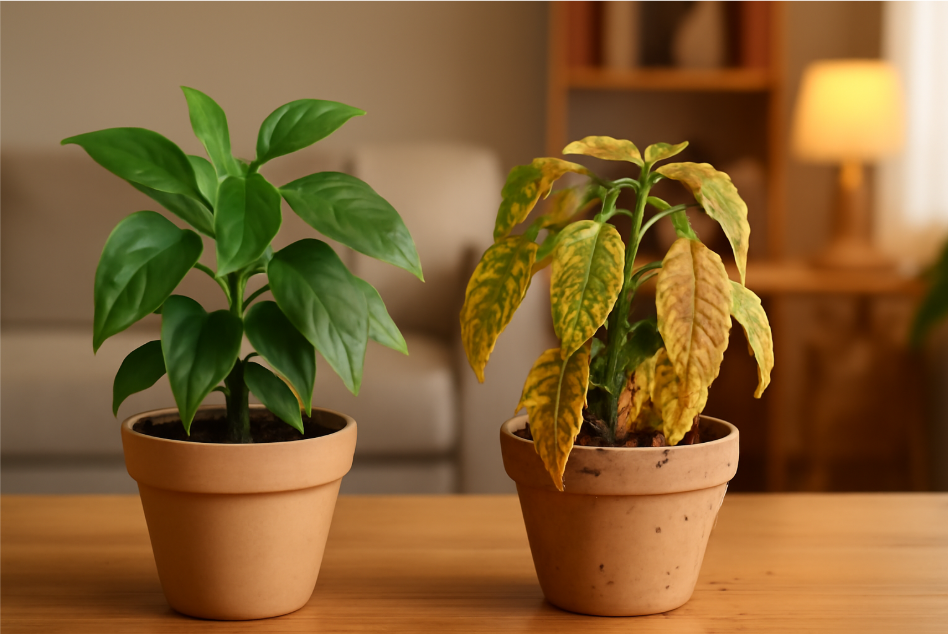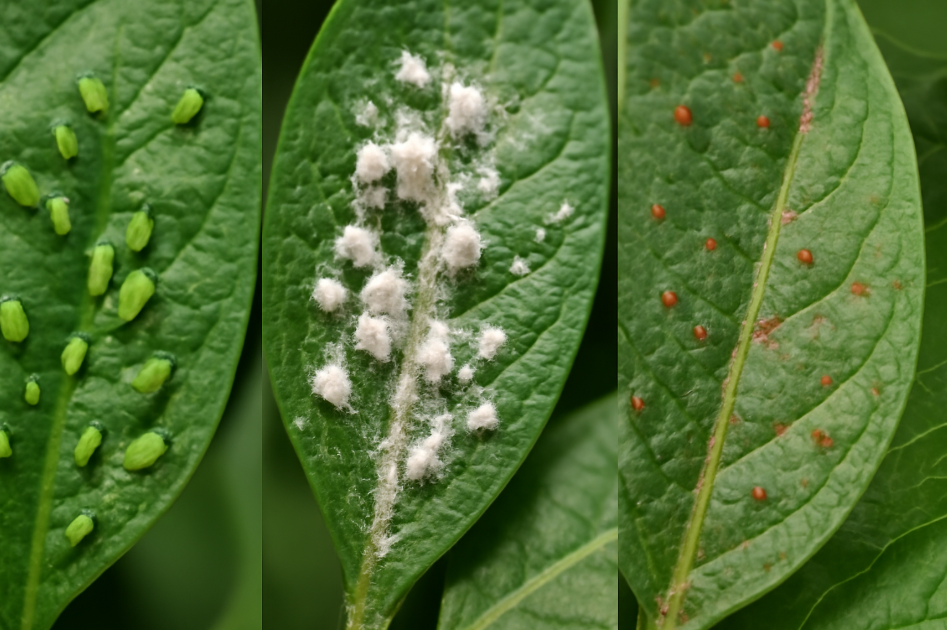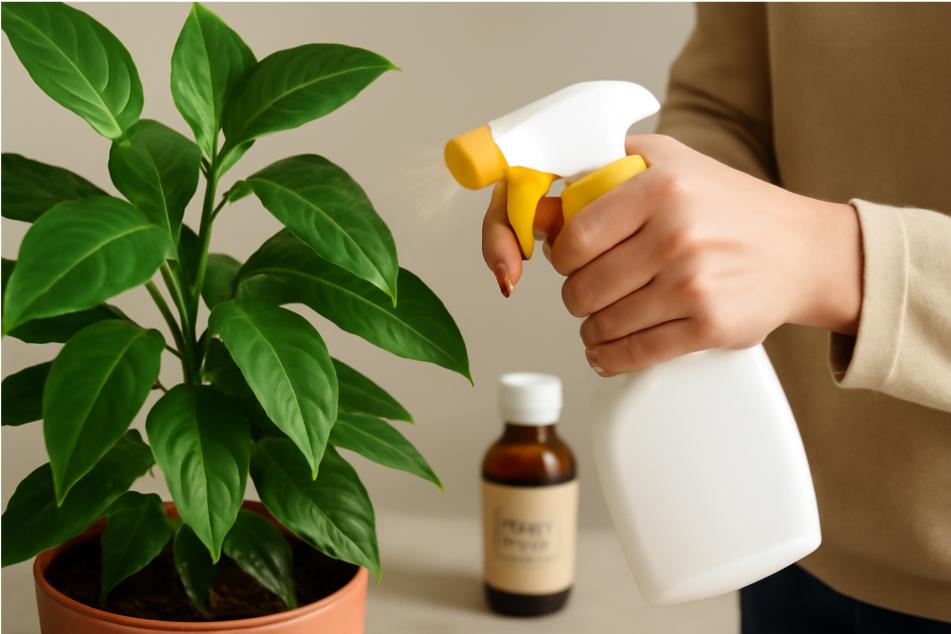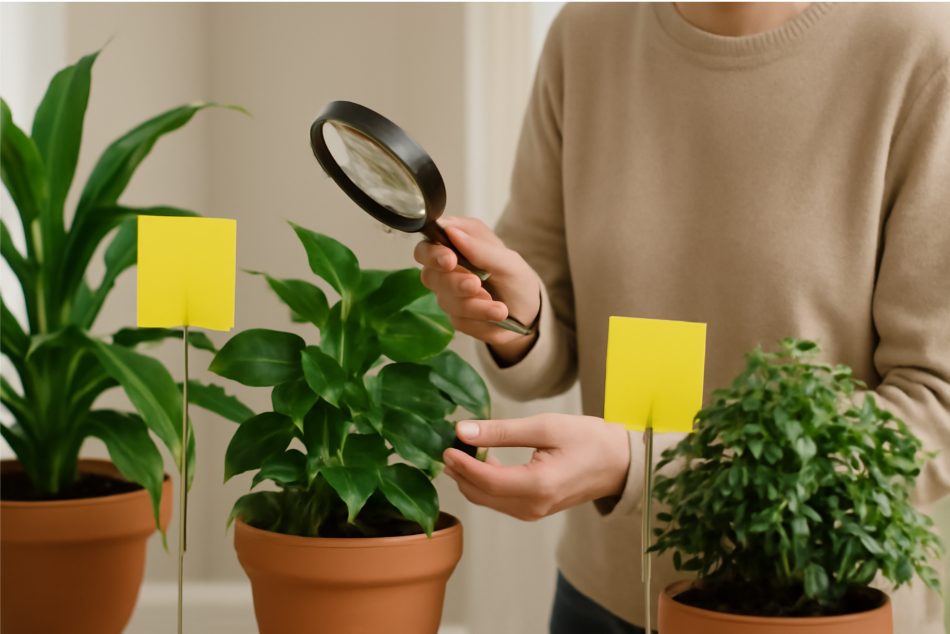
How to Treat Indoor Plant Pests: Proven Methods to Keep Your Plants Healthy and Pest-Free
Are your indoor plants looking a bit unhealthy? 
Indoor plants are prone to pests like aphids, spider mites, and mealybugs, which can weaken their growth and affect their beauty. The good news is that you don’t need to be a gardening expert to solve this problem. In this article, we’ll explore proven, easy-to-follow methods to protect your plants from pests and ensure they thrive.
Keep reading to discover simple, effective techniques that will make your plants pest-free and healthy once again. Let’s dive into the essential steps you need to take to keep your indoor garden flourishing!
Table of Contents
ToggleSection 1: Understanding Indoor Plant Pests
Indoor plant pests can be a real headache for plant owners. These tiny invaders can quickly take over your plants, damaging their leaves, stems, and roots. But before you can treat them, it’s essential to understand what you’re dealing with. Let’s break it down.

What Are Indoor Plant Pests?
Indoor plant pests are small insects, mites, or even fungi that live on or near your plants. They feed on your plant’s sap or tissues, causing harm in various ways. Some pests are easy to spot, while others are tiny and can go unnoticed for a while.
Common Types of Pests
- Aphids: These soft-bodied insects are often found on new growth and leaves. They suck plant juices, causing leaves to yellow and curl.
- Mealybugs: Tiny, white, cotton-like pests that hide under leaves and on stems, they weaken the plant and sometimes leave a sticky residue.
- Spider Mites: These almost invisible pests can damage plants by sucking out cell contents, leaving tiny speckles or webs on the underside of leaves.
- Fungus Gnats: Small flies that swarm around the soil. Their larvae can damage roots, affecting plant health.
- Scale Insects: These pests attach themselves to stems and leaves, appearing as small, hard bumps. They can severely stunt plant growth if left untreated.
Signs of Pest Infestation
How can you tell if your indoor plants are infested with pests? Look out for these common signs:
- Yellowing or wilting leaves: This often happens when pests feed on plant sap, draining it of nutrients.
- Sticky residue (honeydew): If you notice a sticky film on your plants, it could be a sign of aphid or mealybug activity.
- Visible pests: Check the undersides of leaves, stems, and even the soil for tiny insects or webs.
- Deformed leaves: Pests can cause leaves to curl, twist, or fall off prematurely.
By spotting these early signs, you can act fast and prevent the infestation from getting worse.
Why Pests Are Harmful to Your Plants
Pests aren’t just annoying—they can be extremely damaging. Here’s how they affect your plants:
- Weaken Growth: By feeding on plant sap, pests weaken the plant, slowing its growth and making it more susceptible to diseases.
- Disease Spread: Some pests carry viruses, fungi, or bacteria that can spread to your plants, causing even more harm.
- Aesthetic Damage: Pests can ruin the look of your plants, making them less vibrant or even unhealthy.
Now that you understand the types of pests and their impact, you can be more vigilant in identifying them and taking action. The next step is learning how to treat them effectively—stay tuned!
Section 2: How to Prevent Indoor Plant Pests
Prevention is always better than cure, especially when it comes to indoor plant pests. By taking a few simple steps, you can reduce the risk of infestations and keep your plants healthy and pest-free. Let’s dive into the most effective ways to protect your indoor plants from pests.

1. Keep Your Plants Clean
A clean plant is a happy plant! Regularly wiping down your plants helps remove dust, debris, and any tiny pests that may have settled on them.
- Wipe Leaves: Use a damp cloth to gently wipe both sides of your plant’s leaves once a week. This will help you spot any early signs of pests while also improving air circulation around the plant.
- Remove Dead Leaves: Dead or decaying leaves attract pests. Trim them off to prevent pests from using them as a food source or hiding spot.
2. Choose Healthy Plants
Starting with a healthy plant is one of the best ways to prevent pests. Healthy plants are naturally more resistant to pest attacks.
- Inspect Before Purchase: When buying new plants, check for any visible pests or signs of damage. Look at the undersides of leaves and check the stems.
- Quarantine New Plants: Keep newly purchased plants in isolation for a couple of weeks before introducing them to your other plants. This way, you can monitor them for any hidden pests.
3. Control Environmental Factors
The environment in which your plants live plays a significant role in preventing pests. By managing light, humidity, and temperature, you can discourage pests from taking over.
- Proper Watering: Over-watering can create a damp environment that attracts pests like fungus gnats. Ensure your plants are not sitting in water by using well-draining pots and letting the soil dry out between waterings.
- Humidity Levels: Some pests thrive in high humidity. Maintain an optimal level of humidity (40-60%) for most indoor plants by using a humidifier or placing a tray of water near the plants.
- Good Air Circulation: Pests love still, stagnant air. Make sure your plants have enough airflow to prevent mold and pests from settling in. If possible, place plants in a room with natural ventilation.
4. Avoid Overcrowding Plants
Cramped conditions can stress your plants, making them more vulnerable to pests. Leave enough space between your plants for air to circulate freely.
- Spacing Is Key: Make sure each plant has enough room to grow without touching its neighbors. This will help reduce the spread of pests and disease.
5. Use Natural Pest Repellents
Certain plants and substances act as natural pest repellents, helping to keep your plants safe.
- Essential Oils: Some essential oils, like peppermint, eucalyptus, and lavender, are natural pest deterrents. Use a few drops diluted in water and spray it around your plants.
- Companion Planting: Some plants naturally repel pests. For example, basil and marigolds can help deter aphids and other insects when placed near other plants.
6. Regularly Inspect Your Plants
Prevention is about being proactive. Set aside time each week to inspect your plants for any early signs of pests.
- Look Under the Leaves: Pests like spider mites and mealybugs often hide on the undersides of leaves. Check there regularly.
- Examine the Soil: Fungus gnats and other pests may live in the soil. Make sure the soil isn’t overly moist and inspect it for any unusual movement.
Section 3: Proven Methods to Treat Indoor Plant Pests
Even with the best prevention techniques, pests can still find their way into your indoor garden. If you spot an infestation, don’t panic! There are several proven, effective methods to treat indoor plant pests and get your plants back to health. Let’s explore the most efficient ways to tackle pests head-on.

1. Natural Remedies: Safe and Effective
If you prefer an eco-friendly approach, natural remedies can be a great option for treating indoor plant pests. They’re safe for your plants and the environment, and they often work wonders!
Neem Oil:
- How It Works: Neem oil acts as a natural pesticide by disrupting the feeding and reproductive cycles of pests.
- How to Use: Mix 2 tablespoons of neem oil with 1 liter of water and a few drops of mild liquid soap. Spray generously on the affected areas, including the undersides of leaves where pests like to hide.
- When to Apply: Repeat every 7-10 days until the pests are gone.
Insecticidal Soap:
- How It Works: This soap kills soft-bodied insects like aphids, mealybugs, and spider mites by suffocating them.
- How to Use: Simply buy a ready-made insecticidal soap or mix your own with 1 tablespoon of mild liquid soap in 1 liter of water. Spray it directly on the pests.
- When to Apply: Apply once every 7-10 days until the pests are eradicated.
Diatomaceous Earth:
- How It Works: This powdery substance is made from the fossilized remains of tiny aquatic organisms. It works by piercing the exoskeleton of insects, causing them to dry out and die.
- How to Use: Sprinkle diatomaceous earth on the soil surface or around the base of the plant.
- When to Apply: Reapply after watering or every couple of weeks.
2. Chemical Treatments: Use With Caution
If natural remedies aren’t doing the trick or the infestation is severe, chemical treatments can be an effective solution. However, always read the label carefully and follow the instructions to avoid harming your plants.
- Systemic Insecticides: These products are absorbed by the plant and target pests that feed on it. They can be highly effective against stubborn infestations.
- How to Use: Follow the product instructions for mixing and applying to the soil.
- When to Apply: Systemic insecticides typically work best when applied in early spring or after a plant has been infested for some time.
Spray Insecticides:
- How to Use: Spray directly on the infested areas, including the tops and bottoms of leaves, stems, and around the soil.
- When to Apply: Apply in the evening or early morning to avoid sun damage to the plant and ensure effectiveness.
3. Homemade Solutions: DIY and Budget-Friendly
If you’re looking for an affordable, at-home solution, try these simple DIY remedies. They can be made with ingredients you likely already have around the house.
DIY Soap Spray:
- How It Works: Soap works by breaking down the protective outer layer of pests, causing them to dehydrate.
- Recipe: Mix 1 tablespoon of mild dish soap with 1 liter of water. Stir it up and pour it into a spray bottle.
- How to Use: Spray directly on affected plants, making sure to cover both sides of the leaves.
- When to Apply: Reapply every 5-7 days, depending on the severity of the infestation.
Garlic and Chili Spray:
- How It Works: Garlic and chili are natural deterrents that repel many types of pests, including aphids and mites.
- Recipe: Blend 2-3 garlic cloves and 2-3 dried chilies with 1 liter of water. Strain the mixture and pour it into a spray bottle.
- How to Use: Spray the solution on the affected areas of the plant.
- When to Apply: Repeat every 5-7 days for best results.
4. Manual Removal: Quick and Effective
Sometimes the simplest solution is to tackle the pests directly. While this might not be a long-term solution, it can help control smaller infestations and prevent them from spreading.
Hand-Picking:
- How It Works: For larger pests like scale insects, simply remove them by hand.
- How to Use: Use a cotton swab dipped in rubbing alcohol to wipe off mealybugs or scale insects. For larger pests, gently remove them with your fingers.
- When to Apply: Do this regularly as part of your pest management routine.
Water Spray:
- How It Works: A strong stream of water can knock off many types of pests, especially aphids and spider mites.
- How to Use: Use a hose or a spray bottle with a strong water jet. Direct the spray at the affected areas.
- When to Apply: This works well for early infestations, and you can repeat as needed.
Section 4: Managing Specific Pests
Different pests require different treatments. Understanding how to manage the most common indoor plant pests will help you quickly address the issue and keep your plants healthy. In this section, we’ll cover how to handle some of the most common indoor plant pests, including aphids, mealybugs, spider mites, fungus gnats, and scale insects. Let’s dive in!

1. Aphids: Small But Destructive
Aphids are soft-bodied insects that love to feed on the sap of your plants. They often appear in clusters on the undersides of leaves, new growth, or flower buds.
- How to Identify: Look for tiny, pear-shaped insects that can be green, black, or even yellow. You may also notice sticky, sugary residue on your plants—this is called honeydew, which aphids excrete.
How to Treat:
- Natural Remedies: Spray with neem oil or insecticidal soap to suffocate the aphids.
- DIY Solution: Make a soap spray by mixing 1 tablespoon of mild dish soap with 1 liter of water. Spray directly on the aphids, making sure to cover all affected areas.
- Prevention: Introduce natural predators like ladybugs, which feed on aphids.
2. Mealybugs: The Cotton-Like Pests
Mealybugs are tiny pests that create a cotton-like mass, making them easy to spot. They feed on plant sap, weakening your plant and causing yellowing leaves.
- How to Identify: Look for white, fluffy patches on leaves, stems, and around the base of the plant.
How to Treat:
- Manual Removal: Dab a cotton swab in rubbing alcohol and remove mealybugs directly from the plant. Alcohol kills them on contact.
- Natural Remedies: Apply neem oil or insecticidal soap to the affected areas.
- Prevention: Regularly inspect your plants for mealybugs, especially in hard-to-reach spots.
3. Spider Mites: Tiny but Mighty
Spider mites are so small they’re often hard to see without a magnifying glass. These pests can cause significant damage by sucking out plant juices, leaving behind tiny webs and yellowing leaves.
- How to Identify: Look for fine webbing on the underside of leaves. You may also notice tiny, speckled yellow or brown spots on the leaves.
How to Treat:
- Water Spray: Rinse the plant with a strong stream of water to dislodge the mites.
- Natural Remedies: Use a mixture of neem oil and water or insecticidal soap. Apply it directly to the affected areas, especially the undersides of leaves.
- Prevention: Regularly check plants for webs, especially during dry weather, as spider mites thrive in low humidity.
4. Fungus Gnats: Tiny Flies, Big Problems
Fungus gnats are small flying insects that often infest the soil of your plants. Their larvae can damage the roots, leading to poor plant growth.
- How to Identify: You’ll see tiny black flies buzzing around the soil surface or hovering near the plant. The larvae are invisible to the naked eye but live in the soil, feeding on roots.
How to Treat:
- Water Management: Fungus gnats thrive in moist environments, so allow the top inch of soil to dry out between waterings.
- Sticky Traps: Place yellow sticky traps around the plant to catch adult gnats.
- Soil Treatment: Sprinkle diatomaceous earth on the soil surface to help kill the larvae.
5. Scale Insects: Hard to Spot, Hard to Kill
Scale insects are small, hard-bodied pests that attach themselves to your plant’s stems and leaves, sucking out vital nutrients.
- How to Identify: Scale insects appear as small, round bumps on the stems or leaves. They can be brown, gray, or black in color.
How to Treat:
- Manual Removal: Use a soft brush or your fingers to scrape the scale insects off the plant. Douse the affected areas with rubbing alcohol to kill any remaining pests.
- Natural Remedies: Apply horticultural oil or neem oil to smother the pests.
- Prevention: Regularly inspect your plants, especially the stems, where scale insects love to hide.
Section 5: Long-Term Pest Management
Once you’ve dealt with an indoor plant pest infestation, the next step is to ensure it doesn’t happen again. Long-term pest management is about creating a healthy environment for your plants and maintaining vigilance to prevent future problems. With the right habits and strategies, you can keep pests at bay for good!

1. Regular Inspections: Catch Problems Early
The key to long-term pest control is regular monitoring. By inspecting your plants weekly, you can catch any early signs of pests before they become a bigger issue.
- Check Leaves and Stems: Focus on the undersides of leaves and around the stems, where pests love to hide.
- Examine the Soil: Look for any movement in the soil, especially from fungus gnat larvae.
- Look for Webs or Discoloration: Fine webs or yellowing leaves are often early indicators of pests like spider mites or aphids.
2. Maintain a Clean Growing Environment
A clean environment makes it harder for pests to settle in. Incorporating regular plant care practices will create an unwelcoming habitat for pests.
- Wipe Leaves Regularly: Use a damp cloth to clean the leaves and remove any dust or pests.
- Remove Dead or Damaged Leaves: Pests are drawn to decaying plant matter, so always remove any dead or yellowing leaves to prevent attracting them.
- Clean Pots and Tools: Regularly disinfect your plant pots, gardening tools, and containers to avoid cross-contamination between plants.
3. Use Preventative Treatments
Incorporating mild, preventative treatments can help keep pests away without harming your plants.
- Neem Oil: Apply a light neem oil treatment once a month to create a barrier that repels pests. It’s a natural way to keep insects from settling on your plants.
- Insecticidal Soap: A gentle insecticidal soap applied once a month can prevent pests like aphids, mealybugs, and spider mites from taking hold.
- Essential Oils: Peppermint, lavender, or eucalyptus oils can be used as a natural deterrent. Simply dilute a few drops in water and spray around your plants.
4. Proper Watering and Humidity Control
Overwatering and high humidity can create the perfect breeding grounds for pests. To reduce the chances of infestations:
- Water Properly: Avoid letting your plants sit in standing water, which can attract pests like fungus gnats. Ensure your pots have good drainage.
- Control Humidity: Keep humidity levels in check (40-60%)—not too high to attract pests, and not too low to stress your plants.
5. Introduce Natural Predators
A natural and effective way to prevent pests is by encouraging or introducing beneficial insects that prey on pests.
- Ladybugs: These natural predators are known for their love of aphids, mealybugs, and other small pests. You can buy ladybugs and release them onto your plants.
- Predatory Mites: These mites feed on other mites, including spider mites, and can be introduced into your indoor garden to help control pests.
6. Avoid Overcrowding Plants
Overcrowding plants can stress them out, making them more susceptible to pests. To prevent this:
- Give Plants Space: Ensure that each plant has enough room for air to circulate around it. This will not only help prevent pests but will also improve plant health.
- Move Plants Around: Rotate your plants periodically to prevent pests from taking hold in one spot.
7. Be Careful with New Plants
New plants can bring in pests, even if they appear healthy. To avoid introducing new pests:
- Quarantine New Plants: Before adding a new plant to your collection, keep it in isolation for a couple of weeks to monitor for any pests.
- Inspect Before Buying: Carefully inspect new plants for pests, especially around the leaves, stems, and soil.

Dealing with indoor plant pests can feel overwhelming at times, but with the right knowledge and techniques, you can keep your plants healthy, thriving, and pest-free. From understanding the types of pests that affect your plants to implementing effective treatments and prevention strategies, you’ve now got the tools to protect your indoor garden.
Remember, consistency is key! Regular inspections, proper watering habits, and using natural or chemical treatments when necessary will help you stay ahead of any pest problems.
By following the steps outlined in this article, you’re not only solving the immediate pest issue but also creating a long-term plan to ensure your plants remain healthy for years to come.
Don’t let pests hold you back from enjoying the beauty of your indoor plants. With a little effort, your plants can flourish, pest-free, in a space you love. Happy gardening!
Frequently Asked Questions (FAQs)
1. How can I tell if my indoor plant has pests?
To spot pests, look for signs like yellowing or curling leaves, sticky residue (honeydew), fine webs, or visible insects. Inspect the undersides of leaves and stems, as these are common hiding spots for pests. Regular checks will help catch infestations early.
2. What’s the best natural way to treat indoor plant pests?
Neem oil is one of the most effective natural treatments for indoor plant pests. Mix 2 tablespoons of neem oil with water and spray it on the affected areas. It disrupts pest growth and is safe for most plants when used properly.
3. How do I get rid of mealybugs on my plants?
Mealybugs can be removed with rubbing alcohol. Soak a cotton swab in alcohol and gently dab it on the pests. You can also use insecticidal soap or neem oil for more widespread infestations.
4. Can I use chemical pesticides on indoor plants?
Yes, chemical pesticides can be used, but they should be a last resort. Always read the label to ensure the pesticide is safe for indoor use and follow the instructions carefully. Consider starting with natural remedies before opting for chemicals.
5. How do I prevent pests from coming back?
Regularly clean your plants, remove dead leaves, and inspect them weekly for any early signs of pests. Maintain proper watering practices and humidity control to avoid creating an environment that attracts pests. Quarantining new plants for a few weeks also helps prevent infestations.
6. Are there any home remedies for treating spider mites?
Yes! A simple water spray can help dislodge spider mites. You can also use neem oil or insecticidal soap to treat affected areas. Be sure to spray the underside of leaves, where spider mites tend to hide.
7. How often should I treat my plants for pests?
Treat your plants every 7-10 days until the pest problem is resolved. For preventative care, applying a mild treatment like neem oil once a month can help keep pests at bay. Regular inspections are crucial for catching issues early.
8. What should I do if my plant soil has fungus gnats?
To control fungus gnats, let the top inch of soil dry out between waterings, as they thrive in moist conditions. You can also place yellow sticky traps near the plant to capture adult gnats. Additionally, diatomaceous earth can help by killing the larvae in the soil.




